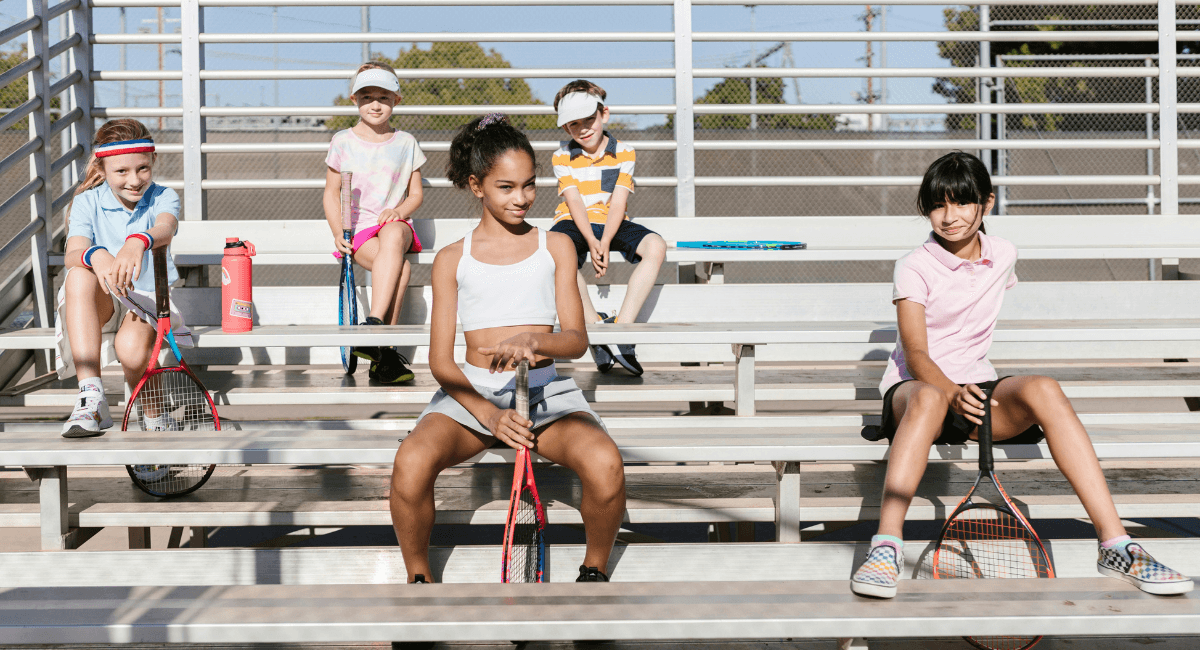Top Junior Tennis Rackets: Best Tennis Racket for Kids

The selection of the best tennis racket for kids plays an important role in developing him or her. A great racket will make the game a wonderful experience and develop the various skills as they go with it, reducing the chances of getting injured. Here in this guide, we present what factors you have to consider when choosing the most suitable racket for your children, the top models considered, and some tips for maintaining the equipment so the life of your rackets can be extended.
Why is the Right Tennis Racket Important for Kids?
Playing tennis is a big deal for kids. The wrong racket will lead to improper form due to rackets that are too heavy or too big, causing frustration and discouragement in the game. But if your child gets the right racket, it can aid in proper techniques, speed up learning, and more importantly, make it enjoyable.
A racket that suits the age, size, and skill level of the child makes them play comfortably. This brings about confidence and ease in learning new skills. Moreover, a right racket reduces strain on the wrists, elbows, and shoulders.

Key Factors to Consider When Choosing Best tennis racket for kids
Age and Height of the Child
Before buying, know the age and height of your child compared to a junior racket. If the racket becomes too long or too short for his or her height, then his or her game will easily be affected.
In general, the following shows what age and height indicate a particular racket length to look for:
| Age Group | Height | Racket Length |
|---|---|---|
| 4–6 years | Less than 44 inches | 19 inches |
| 6–8 years | 44–50 inches | 21–23 inches |
| Age, Gender | ||
| 9–10 years | 50–55 inches | 25 inches |
| 11+ years | Over 55 inches | 26 inches |
A racket of appropriate size for your child will help them to have control over the racket and accurately hit the balls.
Weight and Balance of the Racket
The weight and balance of the racket determine how easy it is for a child to swing. The lighter racket is easier to handle and control by the young players. However, it has also got to have proper balance so that the racket does not feel too head-heavy or head-light.
Head-heavy rackets will give more power and momentum, whereas head-light rackets give a feel of better control over the ball. A head-light racket is suitable for novices as it will facilitate more control over the ball.
Grip Size and Comfort
A comfortable grip would improve his game and reduce hand strain. The appropriate size of the grip would enable him to hold the racket without overexerting himself. If the grip is too small, he would overgrip it, and that would put him in tension in his hand and wrist. And if the grip is too big, it would be a little awkward, and they’d struggle with control.
Based on the chart, take a proper grip on your child’s hand.
- Grip 0 (4 inches) small hands
- Grip 1 (4 1/8 inches) medium hand
- Grip 2 (4 1/4 inch) bigger hand Measure from the top of your child’s wrist by instructing your child to grasp the racket comfortably; that is leaving space to slide your finger in between fingers and his or her palms.

Racket Material
Junior rackets vary by material. These could impact the durability and performance of rackets. Most junior rackets are made of either aluminum or graphite, sometimes even both.
- For beginners, aluminum is good because it’s a very strong material that’s also relatively light.
- Graphite-based rackets are usually for players of intermediate or advanced caliber since they’re softer in comparison.
- Graphite composite rackets combine the strengths of graphite and aluminum, which is perfect for kids who want a balance of power and control.
Skill Level and Playing Style
The type of racket would depend upon the skill level and the playing style of your child. For beginners, large-headed rackets with forgiving sweet spots are ideal since they allow easy contact with the ball. For the intermediates and advanced, better control and precision will have to be offered.
- Beginners: Larger-headed racket with a forgiving sweet spot.
- Intermediate: Balancing rackets that will offer more control.
- Advanced: Precision-driven racquets for the serious player.
Top Junior Tennis Racquets of 2024
A few of the best racquets for juniors will be listed below. Racquets are recommended based on performance, durability, and the age-appropriate look for the junior player below:
Wilson Junior Blade 25
- Racket Length: 25 inches
- Material: Graphite
- Skill Level: Intermediate/Advanced
- Price Range: $70–$100
This Wilson Junior Blade 25 is a racket with top quality that gives great accuracy and performance. The racket is suitable for those who have passed the beginners and aim to improve the game much more. The racket is light but offers full control. It, thus, is the racket to be used by advanced or intermediate players.
- Advantages: Control is on the top; so does the spin.
- Cons: Costly.
Babolat Aero Junior 26
- Length: 26 inches
- Material: Graphite
- Skill Level: Advanced
- Price Range: $80–$120
The Babolat Aero Junior 26 is one of the best racquets for skill-hanging in young players. The aerodynamic frame helps in power and spin production and is good for a player who already has some basis.
- Pros: Good spinning, powerful.
- Disadvantages: Not even suitable for a beginner’s racket.
Head Speed 23 Junior
- Racket Length: 23 “
- Material: Aluminium
- Skill Level: Beginner
- Price Range: $ 40-$ 60
The Head Speed 23 Junior is a good racket for a beginner. It is light in weight, with more head size, and thus helps the ball come into better contact. The ball always comes to young players so that they can hit the ball properly, and also it is very economical.
- Pros: Affordable, Durable.
- Cons: Not ideal for professional players.
Yonex EZONE 25
- Length: 25 inches
- Material: Graphite
- Skill Level: Intermediate/Advanced
- Price Range: $90–$120
The Yonex EZONE 25 is designed with the latest technology that provides comfort and accuracy. The racket reduces vibrations that cause discomfort and arm fatigue during prolonged play.
- Pros: It has shock-absorbing technology, lightweight.
- Cons: A tad heavier than other models.
Prince Warrior Junior 26
- Length of Racket: 26 inches – Material Used: Aluminum – Level: All Levels
- Price Range: $50-$80
The Prince Warrior Junior 26 is the best tennis racket that generally represents an all-around good performer suitable for junior tennis. That in itself caught a lot of parents’ attention and thus, value with performance.
Drawbacks: The string would need to be re-tensioned a lot.

Junior Tennis Racket Care Instructions
Proper care should be taken to ensure your child’s tennis racket lasts for as long as it should. Here are the ways to maintain the racket.
- Store the Racket Properly Store the racket in a protective case when it is not in use. Avoid leaving it in direct sunlight or extreme temperatures as this can damage the frame and strings.
- Inspect for Damage Inspect the racket for damage. The primary concern is cracks and dents in the frame. For the strings, inspect them regularly for signs of wear; replace them when the strings start to fray or lose tension.
- Clean the Racket Clean the frame with a damp cloth after use to remove dirt. Clean the grip with mild soap and water. This helps the racket to last longer, hence it will perform efficiently.
- Restring the Racket
As the string wears out, restring the racket to maintain a high performance. This holds true, especially for frequent users.
FQAS
How do I choose the right size tennis racket for my child?
It all depends on the size of the racket you get according to your child’s age and height. Please refer to the size chart of rackets printed on the previous page, and you’ll get the perfect length for your child.
Does my child need to buy an expensive racket?
A mid-range racket would be perfectly okay for your child if you are a beginner. Good performance, no breaking of the bank: that is exactly what a mid-range racket will provide for your child. For intermediate or advanced players, your child needs a high-quality racket to perform.
Can my child use an adult tennis racket?
No, adult rackets are way too heavy for kids to grow into. You want to get your child a junior racket-sized right for their age and skill level.
What is the best tennis racket for beginners?
The Head Speed 23 Junior would be an excellent starting point. It is light, and also highly durable, aside from being very cheap.
How do I measure the grip size for my child?
For grip size, have your child hold the racket with enough space to fit a pencil between their fingers and palm.
Conclusion
There is a significant difference between getting the right tennis racket and not getting it for your child. Especially when it comes to choosing the best tennis racket for kids, about age, height, skill level, and the size of the grip, your child’s success in the sport and enjoyment of it will be highly determined. With proper equipment, your child develops skills and enjoys tennis for life.
A good racket improves one’s performance and ensures safe and enjoyable playing. Selecting the best racket does not matter if someone starts or develops advanced skills; it helps the latter enjoy the game even while improving.
